Mary Quattlebaum's Blog, page 14
February 1, 2016
VERB POWER WITH CLAUDIA MILLS
Guest Post by Claudia Mills
Verbs are action words, strong words that let characters make something happen in a story. But some verbs are stronger than others. Strong verbs don’t need qualifying adverbs to help them out. Strong verbs can stand on their own because they convey a distinctive shade of meaning.
Consider all the verbs that are variants of walk, meaning “go along on foot.” Just a few entries for walk in a thesaurus include: stroll, march, tramp, prance, saunter, race, roam, trek, parade, wander, amble, strut, plod, trudge, shuffle, stalk, pace, plod, sprint, tiptoe. Each one conveys a different kind of gait, for a different kind of character, in a different kind of mood. You could write “Jane walked slowly” or you could write “Jane trudged.” You could write “John walked quickly,” or you could write “John raced.” A little girl showing off her new hair ribbons might prance; an old man worried about falling might shuffle. Someone who is leaving a room angrily stalks away; someone who is walking along dreamily wanders or meanders. With a strong enough verb, the adverb is unnecessary.

In the first chapter of my recent book Simon Ellis: Spelling Bee Champ, a video game character springs over a string of fireballs and then plunges into space; a pet ferret scrambles out the door and scrabblesup someone’s arm. In later chapters, a dog bounces after a kid; the enthusiastic principal popsinto the classroom one day and and boundsinto it on another; one girl trailsafter another (showing reluctance to go). All of these are verbs that move a character from one place to another, but they do so in such vividly different ways.
Take my list of motion verbs, above, or a list you’d find for the entry “walk” in any good thesaurus. Invite kids to come to the front of the room to act out each one. Have them strut, march, saunter, amble. Where they don’t know the meaning of the word, you may have to join in the acting yourself, or provide a sentence to give context: “Andy was so proud of his new football jersey that he strutted to the front of the room so that everyone could see,” or “Ellie felt the weight of the world on her shoulders as she plodded to the car.”
Give the students a list of motion verbs qualified with adverbs: walk quickly, walk slowly, walk happily, walk sadly, walk confidently, walk fearfully. Ask the students to find a substitute stronger verb to take the place of each verb + adverb combination.
Finally, invite the students to speculate on why a person might be strutting, marching, sauntering, ambling, pacing, plodding, or sprinting. What just happened before this moment to make him or her walk in this way? Where is he or she trying to go? And why? What is going to happen next? Strong verbs don’t just contribute action to a story. They can be the start of a story, too!
 BIO: Claudia Mills is the author of over 50 books for young readers, including How Oliver Olson Changed the World (an ALA Notable Book of the Year) and The Trouble with Ants (which just received a starred review in Publishers Weekly), as well as the Franklin School Friends series of chapter books from Farrar, Straus & Giroux. Claudia lives in Boulder, Colorado, with her family and her cat, Snickers. Visit www.claudiamillsauthor.com.
BIO: Claudia Mills is the author of over 50 books for young readers, including How Oliver Olson Changed the World (an ALA Notable Book of the Year) and The Trouble with Ants (which just received a starred review in Publishers Weekly), as well as the Franklin School Friends series of chapter books from Farrar, Straus & Giroux. Claudia lives in Boulder, Colorado, with her family and her cat, Snickers. Visit www.claudiamillsauthor.com.
Verbs are action words, strong words that let characters make something happen in a story. But some verbs are stronger than others. Strong verbs don’t need qualifying adverbs to help them out. Strong verbs can stand on their own because they convey a distinctive shade of meaning.
Consider all the verbs that are variants of walk, meaning “go along on foot.” Just a few entries for walk in a thesaurus include: stroll, march, tramp, prance, saunter, race, roam, trek, parade, wander, amble, strut, plod, trudge, shuffle, stalk, pace, plod, sprint, tiptoe. Each one conveys a different kind of gait, for a different kind of character, in a different kind of mood. You could write “Jane walked slowly” or you could write “Jane trudged.” You could write “John walked quickly,” or you could write “John raced.” A little girl showing off her new hair ribbons might prance; an old man worried about falling might shuffle. Someone who is leaving a room angrily stalks away; someone who is walking along dreamily wanders or meanders. With a strong enough verb, the adverb is unnecessary.

In the first chapter of my recent book Simon Ellis: Spelling Bee Champ, a video game character springs over a string of fireballs and then plunges into space; a pet ferret scrambles out the door and scrabblesup someone’s arm. In later chapters, a dog bounces after a kid; the enthusiastic principal popsinto the classroom one day and and boundsinto it on another; one girl trailsafter another (showing reluctance to go). All of these are verbs that move a character from one place to another, but they do so in such vividly different ways.
Take my list of motion verbs, above, or a list you’d find for the entry “walk” in any good thesaurus. Invite kids to come to the front of the room to act out each one. Have them strut, march, saunter, amble. Where they don’t know the meaning of the word, you may have to join in the acting yourself, or provide a sentence to give context: “Andy was so proud of his new football jersey that he strutted to the front of the room so that everyone could see,” or “Ellie felt the weight of the world on her shoulders as she plodded to the car.”
Give the students a list of motion verbs qualified with adverbs: walk quickly, walk slowly, walk happily, walk sadly, walk confidently, walk fearfully. Ask the students to find a substitute stronger verb to take the place of each verb + adverb combination.
Finally, invite the students to speculate on why a person might be strutting, marching, sauntering, ambling, pacing, plodding, or sprinting. What just happened before this moment to make him or her walk in this way? Where is he or she trying to go? And why? What is going to happen next? Strong verbs don’t just contribute action to a story. They can be the start of a story, too!
 BIO: Claudia Mills is the author of over 50 books for young readers, including How Oliver Olson Changed the World (an ALA Notable Book of the Year) and The Trouble with Ants (which just received a starred review in Publishers Weekly), as well as the Franklin School Friends series of chapter books from Farrar, Straus & Giroux. Claudia lives in Boulder, Colorado, with her family and her cat, Snickers. Visit www.claudiamillsauthor.com.
BIO: Claudia Mills is the author of over 50 books for young readers, including How Oliver Olson Changed the World (an ALA Notable Book of the Year) and The Trouble with Ants (which just received a starred review in Publishers Weekly), as well as the Franklin School Friends series of chapter books from Farrar, Straus & Giroux. Claudia lives in Boulder, Colorado, with her family and her cat, Snickers. Visit www.claudiamillsauthor.com.
Published on February 01, 2016 14:00
January 25, 2016
Writing Connections with Marc Tyler Nobleman
by Mary Quattlebaum
The Power of Words. Students have heard that phrase so often that it sounds like a cliché. Marc Tyler Nobleman not only brings that phrase to life in two riveting biographies, but he also shows how the biographies themselves helped to right a wrong. In a Kids Post interview for the Washington Post, Nobleman talks about the research and writing process for Boys of Steel and Bill the Boy Wonder, his biographies, respectively, of Jerry Siegel and Joe Shuster, creators of Superman, and of Bill Finger, who co-created Batman with Bob Kane. Finger never received credit for his work until recently, thanks in large part to information uncovered by Nobleman.

Nobleman travels frequently to give presentations and writing workshops, and he has found that, from India to Indiana, people know about Superman and Batman. These superheroes tap into the human hunger for tales of good vs. evil.
Below are a few writing prompts for the classroom or for individual writers ages 8 and up. Nobleman’s blog Noblemania.blogspot.com is a trove of historic photos, comic book art, quotes and cool stuff.

CREATE YOUR OWN SUPERHERO: Ask students to read Bill the Boy Wonder and to look at one or two Batman comic books.
Classroom Discussion: How did Bill Finger help to create Batman? What traits, nicknames or pieces of costume did Bill add? Ask students why they think that superheroes and superhero comic books are so popular, around the world.
Fight or Find Peace: In most comic books, the superheroes use physical force when they fight. Are there other ways of being powerful besides physical force? Other ways of fighting back? As a class, brainstorm a list of people (historic or contemporary) who were powerful without using physical force or violence.
Classroom Writing: Have students brainstorm attributes for their own superhero. For example, what is the hero’s super power? How and when does the hero wield it? Is there a secret identity or costume? Who is the hero’s worst enemy and what are the enemy’s attributes? How and why did the hero become a hero and the bad guy a bad guy? What makes the superhero weak? What makes the villain weak? (Remember, neither hero nor villain need be human. Either or both can be animals, objects, plants, germs, etc.)

Starting Strong: Begin a story about how your hero and villain meet for the first time. Think about who, what, when, where, and how. What brings them together and when and where? What happens? How do they fight? See if students can figure out at least one way that the superhero fights the villain in a non-violent/nonphysical way. What happens then?
Examining Art: Choose a panel or two from a comic book and show students how the illustrator showed a close up or an aerial view, for example. Ask them what makes these different views interesting and why the illustrator may have chosen to show that. Ask them to do one part of their story as a comic book panel, showing a close-up or an aerial view. How did that help them to think about their story in a different way?
www.maryquattlebaum.com
The Power of Words. Students have heard that phrase so often that it sounds like a cliché. Marc Tyler Nobleman not only brings that phrase to life in two riveting biographies, but he also shows how the biographies themselves helped to right a wrong. In a Kids Post interview for the Washington Post, Nobleman talks about the research and writing process for Boys of Steel and Bill the Boy Wonder, his biographies, respectively, of Jerry Siegel and Joe Shuster, creators of Superman, and of Bill Finger, who co-created Batman with Bob Kane. Finger never received credit for his work until recently, thanks in large part to information uncovered by Nobleman.

Nobleman travels frequently to give presentations and writing workshops, and he has found that, from India to Indiana, people know about Superman and Batman. These superheroes tap into the human hunger for tales of good vs. evil.
Below are a few writing prompts for the classroom or for individual writers ages 8 and up. Nobleman’s blog Noblemania.blogspot.com is a trove of historic photos, comic book art, quotes and cool stuff.

CREATE YOUR OWN SUPERHERO: Ask students to read Bill the Boy Wonder and to look at one or two Batman comic books.
Classroom Discussion: How did Bill Finger help to create Batman? What traits, nicknames or pieces of costume did Bill add? Ask students why they think that superheroes and superhero comic books are so popular, around the world.
Fight or Find Peace: In most comic books, the superheroes use physical force when they fight. Are there other ways of being powerful besides physical force? Other ways of fighting back? As a class, brainstorm a list of people (historic or contemporary) who were powerful without using physical force or violence.
Classroom Writing: Have students brainstorm attributes for their own superhero. For example, what is the hero’s super power? How and when does the hero wield it? Is there a secret identity or costume? Who is the hero’s worst enemy and what are the enemy’s attributes? How and why did the hero become a hero and the bad guy a bad guy? What makes the superhero weak? What makes the villain weak? (Remember, neither hero nor villain need be human. Either or both can be animals, objects, plants, germs, etc.)

Starting Strong: Begin a story about how your hero and villain meet for the first time. Think about who, what, when, where, and how. What brings them together and when and where? What happens? How do they fight? See if students can figure out at least one way that the superhero fights the villain in a non-violent/nonphysical way. What happens then?
Examining Art: Choose a panel or two from a comic book and show students how the illustrator showed a close up or an aerial view, for example. Ask them what makes these different views interesting and why the illustrator may have chosen to show that. Ask them to do one part of their story as a comic book panel, showing a close-up or an aerial view. How did that help them to think about their story in a different way?
www.maryquattlebaum.com
Published on January 25, 2016 14:00
January 18, 2016
“Freedom never comes on a silver platter”
by Karen Leggett Abouraya
“Ghana reminds us that freedom never comes on a silver platter. It’s never easy…It comes through hard labor and it comes through toil.”

Dr. Martin Luther King, Jr. spoke about Ghana after attending independence celebrations in this West African nation in 1957, at the invitation of Ghana’s new Prime Minister Kwame Nkuramah
Twenty years later, Emmanuel Ofosu Yeboah was born in Ghana.
“Two healthy lungs let out a powerful cry,two tiny fists opened and closed,but only one strong leg kicked.”
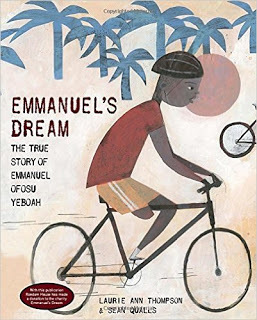
Laurie Ann Thompson wrote and Sean Qualls drew Emmanuel’s Dream: The True Story of Emmanuel Ofosu Yeboah. We often hear about Dr. King’s dream. But Emmanuel had a dream too. Emmanuel hopped to school on his one leg; he played soccer “lunging and spinning on crutches.” He learned to ride a bicycle and when he was only 13, he snuck away to the big city of Accra to earn money to send home.
Emmanuel’s mother died when he was still a boy, but she told him, “Be respectful, take care of your family, don’t ever beg. And don’t give up.”
Those words were a gift. Emmanuel would show everyone that “being disabled does not mean being unable.”
Freedom never comes on a silver platter.

Emmanuel rode his bike all over Ghana. He wanted everyone to see him - and his disability. “People with disabilities left their homes and came outside, some for the very first time….He proved that one leg is enough to do great things - and one person is enough to change the world.” Now he has a foundation called Emmanuel’s Dream that is changing society by empowering people with disabilities.
Emmanuel’s story can inspire student writing (or drawing) at many grade levels.
• What is your dream? What can you do to help make your dream come true?
At first nobody played with Emmanuel, but he earned their respect by learning to kick a soccer ball with his good left foot and learning to balance on his bicycle with the help of a friend.
• What could you do to help someone who seems left out at lunch or on the playground?
Emmanuel’s Dream is a brand new winner of the 2016 Schneider Family Award for books that embody an artistic expression of the disability experience. It is also recommended for Read Africa Week February 1 to 7: the first week of Black History Month. Africa Access and Howard University invite teachers, librarians, parents and other concerned adults to introduce young people to great books about Africa all the time, but especially during Read Africa Week. It is a perfect way to honor Martin Luther King, Jr. and introduce children to new people and countries to admire.
http://childrensbookguild.org/karen-leggett-abouraya
“Ghana reminds us that freedom never comes on a silver platter. It’s never easy…It comes through hard labor and it comes through toil.”

Dr. Martin Luther King, Jr. spoke about Ghana after attending independence celebrations in this West African nation in 1957, at the invitation of Ghana’s new Prime Minister Kwame Nkuramah
Twenty years later, Emmanuel Ofosu Yeboah was born in Ghana.
“Two healthy lungs let out a powerful cry,two tiny fists opened and closed,but only one strong leg kicked.”

Laurie Ann Thompson wrote and Sean Qualls drew Emmanuel’s Dream: The True Story of Emmanuel Ofosu Yeboah. We often hear about Dr. King’s dream. But Emmanuel had a dream too. Emmanuel hopped to school on his one leg; he played soccer “lunging and spinning on crutches.” He learned to ride a bicycle and when he was only 13, he snuck away to the big city of Accra to earn money to send home.
Emmanuel’s mother died when he was still a boy, but she told him, “Be respectful, take care of your family, don’t ever beg. And don’t give up.”
Those words were a gift. Emmanuel would show everyone that “being disabled does not mean being unable.”
Freedom never comes on a silver platter.

Emmanuel rode his bike all over Ghana. He wanted everyone to see him - and his disability. “People with disabilities left their homes and came outside, some for the very first time….He proved that one leg is enough to do great things - and one person is enough to change the world.” Now he has a foundation called Emmanuel’s Dream that is changing society by empowering people with disabilities.
Emmanuel’s story can inspire student writing (or drawing) at many grade levels.
• What is your dream? What can you do to help make your dream come true?
At first nobody played with Emmanuel, but he earned their respect by learning to kick a soccer ball with his good left foot and learning to balance on his bicycle with the help of a friend.
• What could you do to help someone who seems left out at lunch or on the playground?
Emmanuel’s Dream is a brand new winner of the 2016 Schneider Family Award for books that embody an artistic expression of the disability experience. It is also recommended for Read Africa Week February 1 to 7: the first week of Black History Month. Africa Access and Howard University invite teachers, librarians, parents and other concerned adults to introduce young people to great books about Africa all the time, but especially during Read Africa Week. It is a perfect way to honor Martin Luther King, Jr. and introduce children to new people and countries to admire.
http://childrensbookguild.org/karen-leggett-abouraya
Published on January 18, 2016 14:00
January 11, 2016
REMOVING THE POWER OF MEAN WORDS
by Jacqueline Jules
Bullying and name-calling are unfortunately just as much a problem in schools today as they were long ago. Picture books can help students think about the ramifications of unkind behavior and ways to interact differently. With Random Acts of Kindness Week approaching next month, (February 14-20, 2016) here are two book suggestions to get your students writing and discussing better ways of getting along.
Desmond and the Very Mean Word by Archbishop Desmond Tutu and Douglas Carlton Abrams takes place in South Africa and is a story from the Archbishop’s childhood.
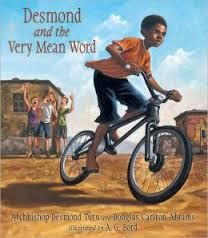
In this story, Desmond’s joy in riding his bicycle is destroyed by a gang of boys who block his path. The tallest boy with red hair shouts a mean word that hurts Desmond’s feelings deeply. The word is never named but it holds great power over Desmond.
“That night, Desmond lay in bed, trying to read his comic book by candlelight. Instead of the words on the page, he kept seeing the mean word written over and over again.”
Later, Desmond tries to exact revenge by shouting the meanest word he can think of at the boy who insulted him. The action only leaves a bitter taste in his mouth. At the end of the story, Desmond confronts the red-haired boy again. This time for apologies. Desmond rides away on his bicycle with outstretched arms, savoring his feeling of freedom and a desire to embrace the world.
My book, Never Say a Mean Word Again, was inspired by a legend from medieval Spain. Since the original tale takes place between two adults, it took me many years to translate its core meaning for young readers.

In Never Say a Mean Word Again, Samuel is the son of the vizier, the most powerful advisor in the royal court. But being the son of an important man does not help clumsy Samuel make friends. When he accidentally spills food all over Hamza’s white tunic at a banquet, angry words are spoken. Samuel looks to his father, the grand vizier, to punish Hamza. The vizier says, “No. You will take care of this matter. Make sure Hamza never says a mean word to you again.”
Like Desmond, in Desmond and the Very Mean Word, Samuel stays awake that night, thinking. How can he make sure that Hamza never says a mean word to him again? Should he make Hamza eat a lemon? Would that be a good punishment for a boy who said mean things? But when Samuel shows up at Hamza’s door, the two boys end up playing ball with the lemon. Later, Samuel charges over to Hamza’s house with pen and paper. He will make Hamza write out a promise. Instead, the boys draw a picture together. Day after day, Samuel visits Hamza with a new plan. Maybe he could beat Hamza at chess or in a water fight. They become used to spending time together and when the vizier finds them playing marbles in the courtyard, he asks his son. “Did you do what I asked? Did you make sure that Hamza never says a mean word to you again?” Samuel looks at his new friend’s smiling face and says, “Yes, Father. I did.”
In Desmond and the Very Mean Word and Never Say a Mean Word Again, two boys ultimately resolve their differences with kindness. Read one or both of these books aloud to your class. Discuss the following questions and choose one of the writing prompts for writing workshop.
Discussion Questions:1. Is it possible to make friends with someone who has insulted you?2. Have you ever made friends with someone or forgiven someone who hurt your feelings?3. What would you do if someone called you a name?4. Is there a fair punishment for name-calling?
Personal Narrative Writing Prompt:Describe a time when you had a misunderstanding or problem with someone. Were angry words spoken? How was the situation resolved?
Fiction Writing Prompt:George is playing basketball alone on the school playground. A student from another class grabs the ball and refuses to let George play. What happens next?
www.jacquelinejules.com
Bullying and name-calling are unfortunately just as much a problem in schools today as they were long ago. Picture books can help students think about the ramifications of unkind behavior and ways to interact differently. With Random Acts of Kindness Week approaching next month, (February 14-20, 2016) here are two book suggestions to get your students writing and discussing better ways of getting along.
Desmond and the Very Mean Word by Archbishop Desmond Tutu and Douglas Carlton Abrams takes place in South Africa and is a story from the Archbishop’s childhood.

In this story, Desmond’s joy in riding his bicycle is destroyed by a gang of boys who block his path. The tallest boy with red hair shouts a mean word that hurts Desmond’s feelings deeply. The word is never named but it holds great power over Desmond.
“That night, Desmond lay in bed, trying to read his comic book by candlelight. Instead of the words on the page, he kept seeing the mean word written over and over again.”
Later, Desmond tries to exact revenge by shouting the meanest word he can think of at the boy who insulted him. The action only leaves a bitter taste in his mouth. At the end of the story, Desmond confronts the red-haired boy again. This time for apologies. Desmond rides away on his bicycle with outstretched arms, savoring his feeling of freedom and a desire to embrace the world.
My book, Never Say a Mean Word Again, was inspired by a legend from medieval Spain. Since the original tale takes place between two adults, it took me many years to translate its core meaning for young readers.

In Never Say a Mean Word Again, Samuel is the son of the vizier, the most powerful advisor in the royal court. But being the son of an important man does not help clumsy Samuel make friends. When he accidentally spills food all over Hamza’s white tunic at a banquet, angry words are spoken. Samuel looks to his father, the grand vizier, to punish Hamza. The vizier says, “No. You will take care of this matter. Make sure Hamza never says a mean word to you again.”
Like Desmond, in Desmond and the Very Mean Word, Samuel stays awake that night, thinking. How can he make sure that Hamza never says a mean word to him again? Should he make Hamza eat a lemon? Would that be a good punishment for a boy who said mean things? But when Samuel shows up at Hamza’s door, the two boys end up playing ball with the lemon. Later, Samuel charges over to Hamza’s house with pen and paper. He will make Hamza write out a promise. Instead, the boys draw a picture together. Day after day, Samuel visits Hamza with a new plan. Maybe he could beat Hamza at chess or in a water fight. They become used to spending time together and when the vizier finds them playing marbles in the courtyard, he asks his son. “Did you do what I asked? Did you make sure that Hamza never says a mean word to you again?” Samuel looks at his new friend’s smiling face and says, “Yes, Father. I did.”
In Desmond and the Very Mean Word and Never Say a Mean Word Again, two boys ultimately resolve their differences with kindness. Read one or both of these books aloud to your class. Discuss the following questions and choose one of the writing prompts for writing workshop.
Discussion Questions:1. Is it possible to make friends with someone who has insulted you?2. Have you ever made friends with someone or forgiven someone who hurt your feelings?3. What would you do if someone called you a name?4. Is there a fair punishment for name-calling?
Personal Narrative Writing Prompt:Describe a time when you had a misunderstanding or problem with someone. Were angry words spoken? How was the situation resolved?
Fiction Writing Prompt:George is playing basketball alone on the school playground. A student from another class grabs the ball and refuses to let George play. What happens next?
www.jacquelinejules.com
Published on January 11, 2016 14:00
January 4, 2016
THE PROBLEM WITH NO PROBLEMS
guest post by Jodi Moore
When I visit schools, I like to pose a question:
“If a football player runs the ball for 100 yards and scores a touchdown, is that exciting?“
I’m almost always met with a loud, unanimous “YES!”
But then I counter with: “Is it exciting if there’s no one on the field to stop him or her?”

This picture usually elicits giggles, but the point is made. A game is only exciting if the players have to overcome obstacles.
The same is true of stories. A tale will fall flat if the main character doesn’t face problems. The more, the merrier! We want to cheer our players – and our characters – on to victory.
“If, Then” stories, like Laura Numeroff’s If You Give A Mouse A Cookie and its wonderful corresponding series, as well as my own When A Dragon Moves In and its sequel When A Dragon Moves In Again, can be used to illustrate how tension works in stories. In my debut picture book, the main human character is faced with convincing his family that his magnificent new dragon friend is real; in the second, he and Dragon must deal with the newest little addition to the family – a baby!

After a reading, ask students the following questions: Who is the main character(s)? What does that character want? What problems stand in his/her way?
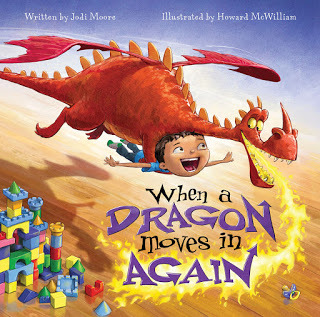
Writing Exercise: Ask your students to write an “If, Then” story. Have them answer the questions above with respect to their own work. Challenge them to create three elements of conflict as the story unfolds, each one ramping up the tension (and excitement!), before resolving the problem.
 Author bio: Jodi Moore is author of the award winning When A Dragon Moves In (Flashlight Press, 2011), its newly released sequel, When A Dragon Moves In Again(Flashlight Press, 2015) and Good News Nelson (Story Pie Press, 2012). Jodi is the proud, (admittedly) neurotic mother of two talented young adults and never ceases to be amazed at how far the umbilical cord will stretch. She loves connecting with readers through school and book events. Jodi lives in Pennsylvania with her husband, Larry, and an ever-changing bunch of characters in her head. Visit her website: www.writerjodimoore.com
Author bio: Jodi Moore is author of the award winning When A Dragon Moves In (Flashlight Press, 2011), its newly released sequel, When A Dragon Moves In Again(Flashlight Press, 2015) and Good News Nelson (Story Pie Press, 2012). Jodi is the proud, (admittedly) neurotic mother of two talented young adults and never ceases to be amazed at how far the umbilical cord will stretch. She loves connecting with readers through school and book events. Jodi lives in Pennsylvania with her husband, Larry, and an ever-changing bunch of characters in her head. Visit her website: www.writerjodimoore.com
When I visit schools, I like to pose a question:
“If a football player runs the ball for 100 yards and scores a touchdown, is that exciting?“
I’m almost always met with a loud, unanimous “YES!”
But then I counter with: “Is it exciting if there’s no one on the field to stop him or her?”

This picture usually elicits giggles, but the point is made. A game is only exciting if the players have to overcome obstacles.
The same is true of stories. A tale will fall flat if the main character doesn’t face problems. The more, the merrier! We want to cheer our players – and our characters – on to victory.
“If, Then” stories, like Laura Numeroff’s If You Give A Mouse A Cookie and its wonderful corresponding series, as well as my own When A Dragon Moves In and its sequel When A Dragon Moves In Again, can be used to illustrate how tension works in stories. In my debut picture book, the main human character is faced with convincing his family that his magnificent new dragon friend is real; in the second, he and Dragon must deal with the newest little addition to the family – a baby!

After a reading, ask students the following questions: Who is the main character(s)? What does that character want? What problems stand in his/her way?

Writing Exercise: Ask your students to write an “If, Then” story. Have them answer the questions above with respect to their own work. Challenge them to create three elements of conflict as the story unfolds, each one ramping up the tension (and excitement!), before resolving the problem.
 Author bio: Jodi Moore is author of the award winning When A Dragon Moves In (Flashlight Press, 2011), its newly released sequel, When A Dragon Moves In Again(Flashlight Press, 2015) and Good News Nelson (Story Pie Press, 2012). Jodi is the proud, (admittedly) neurotic mother of two talented young adults and never ceases to be amazed at how far the umbilical cord will stretch. She loves connecting with readers through school and book events. Jodi lives in Pennsylvania with her husband, Larry, and an ever-changing bunch of characters in her head. Visit her website: www.writerjodimoore.com
Author bio: Jodi Moore is author of the award winning When A Dragon Moves In (Flashlight Press, 2011), its newly released sequel, When A Dragon Moves In Again(Flashlight Press, 2015) and Good News Nelson (Story Pie Press, 2012). Jodi is the proud, (admittedly) neurotic mother of two talented young adults and never ceases to be amazed at how far the umbilical cord will stretch. She loves connecting with readers through school and book events. Jodi lives in Pennsylvania with her husband, Larry, and an ever-changing bunch of characters in her head. Visit her website: www.writerjodimoore.com
Published on January 04, 2016 14:00
December 28, 2015
HOW TO BEHAVE AT SCHOOL
Guest Post by Madelyn Rosenberg
When I wrote my how-to-behave books, I wanted to invoke the idea of a vintage manners book, the kind whose cover stars included a young lady in pin-curls and a young gentleman nearly choked by his skinny, black tie. And, because those books are ridiculously hard to adhere to – So many pages! So many rules! -- I wanted everything to blow up. To make that happen, prim and proper Julia needed a foil (or two or four). And she needed to learn that when it came to fun, other people’s rules were important, too.

The books work to stimulate a discussion with students as you work together to set classroom rules and expectations in September -- or as you revisit those rules at the start of the new year. They also lead into a fun exercise of do’s and don’ts for starting a school day on the right foot.
Here are some examples from my books:From How to Behave at a Tea Party: We DO send out invitations, sip quietly, and hold our tea cups just so.We DO NOT burp like Uncle Victor or make towers out of the tea cups. We do not invite frogs or the Mckagan Brothers.
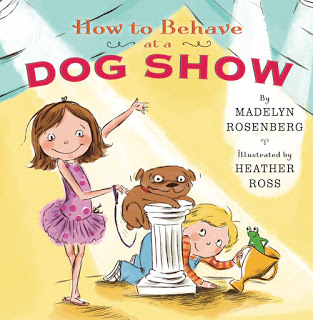
From How to Behave at a Dog Show: We fill out the form, and use a firm but quiet voice.We do not eat the judge’s shoes. Or pants.
In class: Read a How-to-Behave book and have the students discuss what the classroom rules should be. Do we exclude our friends, or is everyone allowed to play? How do we speak to others? How do we make sure everyone gets a chance to share their ideas for classroom fun?
Next, have your students write their own wacky version of a how-to guide for your class. You could start with getting ready for the school day or from the moment the kids arrive in the classroom.
Brainstorm two lists: Things you must do and things you mustn’t. For the mustn’t list, the more outrageous and specific the better. Here are some examples, though of course your results will have your own, unique classroom flare.
Musts:Get on the school bus.Talk quietly with your friends.Walk into the school building.Greet your classmates and teacher with kindness.Share.Feed the fish
Mustn’ts.Bring Shanice’s ball python in your backpack.Yell like Tarzan and tell the bus driver to turn left and drive to England.Knock over the principal.Konk your classmates over the head with a giant pickle.Put every single block and lego and crayon and piece of paper and dress-up thing in a super high castle so that no one can have them but you.Go swimming in the fish tank.
Now put your list together in your best how-to style. You may want to keep it simple, by using must and mustn’t. You may want to mix it up a little more, to sound exasperated like Julia does.
YOU CAN’T ORDER CHINESE TAKEOUT FOR SNACK TIME!YOU’RE SUPPOSED TO EAT GOLD FISH CRACKERS, NOT ACTUAL GOLD FISH!
Let the students decide which should come first in their story and which thing should come last. Having an end point in mind – a time of day, for example – also helps, so work together on a destination. Do you want your story to end at recess, with everyone playing together? Or the end of the school day, with everyone saying they’ll be back again tomorrow, ready to learn? Ask your students to think about the things that will make their own school day end happily ever after.
 As a journalist, Madelyn Rosenberg spent many years writing about colorful, real-life characters. Now she makes up characters of her own. The author of eight books for young people, she lives with her family in Arlington, Va. For more information, visit her web site @ madelynrosenberg.com or follow her on twitter at @madrosenberg. And if you try this exercise in your classroom, she’d love to see the results!
As a journalist, Madelyn Rosenberg spent many years writing about colorful, real-life characters. Now she makes up characters of her own. The author of eight books for young people, she lives with her family in Arlington, Va. For more information, visit her web site @ madelynrosenberg.com or follow her on twitter at @madrosenberg. And if you try this exercise in your classroom, she’d love to see the results!
When I wrote my how-to-behave books, I wanted to invoke the idea of a vintage manners book, the kind whose cover stars included a young lady in pin-curls and a young gentleman nearly choked by his skinny, black tie. And, because those books are ridiculously hard to adhere to – So many pages! So many rules! -- I wanted everything to blow up. To make that happen, prim and proper Julia needed a foil (or two or four). And she needed to learn that when it came to fun, other people’s rules were important, too.

The books work to stimulate a discussion with students as you work together to set classroom rules and expectations in September -- or as you revisit those rules at the start of the new year. They also lead into a fun exercise of do’s and don’ts for starting a school day on the right foot.
Here are some examples from my books:From How to Behave at a Tea Party: We DO send out invitations, sip quietly, and hold our tea cups just so.We DO NOT burp like Uncle Victor or make towers out of the tea cups. We do not invite frogs or the Mckagan Brothers.

From How to Behave at a Dog Show: We fill out the form, and use a firm but quiet voice.We do not eat the judge’s shoes. Or pants.
In class: Read a How-to-Behave book and have the students discuss what the classroom rules should be. Do we exclude our friends, or is everyone allowed to play? How do we speak to others? How do we make sure everyone gets a chance to share their ideas for classroom fun?
Next, have your students write their own wacky version of a how-to guide for your class. You could start with getting ready for the school day or from the moment the kids arrive in the classroom.
Brainstorm two lists: Things you must do and things you mustn’t. For the mustn’t list, the more outrageous and specific the better. Here are some examples, though of course your results will have your own, unique classroom flare.
Musts:Get on the school bus.Talk quietly with your friends.Walk into the school building.Greet your classmates and teacher with kindness.Share.Feed the fish
Mustn’ts.Bring Shanice’s ball python in your backpack.Yell like Tarzan and tell the bus driver to turn left and drive to England.Knock over the principal.Konk your classmates over the head with a giant pickle.Put every single block and lego and crayon and piece of paper and dress-up thing in a super high castle so that no one can have them but you.Go swimming in the fish tank.
Now put your list together in your best how-to style. You may want to keep it simple, by using must and mustn’t. You may want to mix it up a little more, to sound exasperated like Julia does.
YOU CAN’T ORDER CHINESE TAKEOUT FOR SNACK TIME!YOU’RE SUPPOSED TO EAT GOLD FISH CRACKERS, NOT ACTUAL GOLD FISH!
Let the students decide which should come first in their story and which thing should come last. Having an end point in mind – a time of day, for example – also helps, so work together on a destination. Do you want your story to end at recess, with everyone playing together? Or the end of the school day, with everyone saying they’ll be back again tomorrow, ready to learn? Ask your students to think about the things that will make their own school day end happily ever after.
 As a journalist, Madelyn Rosenberg spent many years writing about colorful, real-life characters. Now she makes up characters of her own. The author of eight books for young people, she lives with her family in Arlington, Va. For more information, visit her web site @ madelynrosenberg.com or follow her on twitter at @madrosenberg. And if you try this exercise in your classroom, she’d love to see the results!
As a journalist, Madelyn Rosenberg spent many years writing about colorful, real-life characters. Now she makes up characters of her own. The author of eight books for young people, she lives with her family in Arlington, Va. For more information, visit her web site @ madelynrosenberg.com or follow her on twitter at @madrosenberg. And if you try this exercise in your classroom, she’d love to see the results!
Published on December 28, 2015 14:00
December 21, 2015
THE WHOLE BOOK APPROACH
by Joan Waites
In the newly released book, Reading Picture Books With Children, by Megan Dowd Lambert, (Charlesbridge 2015), Lambert introduces The Whole Book Approach-an alternative to traditional story time.

Instead of reading books TO children, she emphasizes using the picture book as a visual art form, engaging children to participate in what they see and hear.
The chapters are broken down into the different parts of a picture book that make up the whole. The author gives examples of questions to ask students that engage them into looking beyond the surface of what they see. Some of the chapters include information on trim size and orientation, jackets and covers, endpapers, front matter, typography, page design, as well as other artistic and design choices that were made to compliment the story. These design elements might not be seen or realized at first glance, and coaxes the reader to explore them further.
The whole book approach can be used by parents, caregivers, teachers, librarians and even authors and illustrators when doing school presentations.
As the book cover says, “shake up story time and get kids talking about what they see.”
Happy Holidays and Happy New Year to all!
www.joanwaites.com
In the newly released book, Reading Picture Books With Children, by Megan Dowd Lambert, (Charlesbridge 2015), Lambert introduces The Whole Book Approach-an alternative to traditional story time.

Instead of reading books TO children, she emphasizes using the picture book as a visual art form, engaging children to participate in what they see and hear.
The chapters are broken down into the different parts of a picture book that make up the whole. The author gives examples of questions to ask students that engage them into looking beyond the surface of what they see. Some of the chapters include information on trim size and orientation, jackets and covers, endpapers, front matter, typography, page design, as well as other artistic and design choices that were made to compliment the story. These design elements might not be seen or realized at first glance, and coaxes the reader to explore them further.
The whole book approach can be used by parents, caregivers, teachers, librarians and even authors and illustrators when doing school presentations.
As the book cover says, “shake up story time and get kids talking about what they see.”
Happy Holidays and Happy New Year to all!
www.joanwaites.com
Published on December 21, 2015 14:00
December 14, 2015
Writing Connections with Sandra Moore and Kazumi Wilds
by Mary Quattlebaum

Wars rage across the world, but rarely is there talk of the efforts undertaken by ordinary people to promote peace. Sandra Moore and Kazumi Wilds tell the story of one such effort in their picture book The Peace Tree from Hiroshima (Tuttle, ages 8 and up). This little bonsai was owned by the Yamaki family in Japan for almost 400 years, and it survived the U.S. atomic bombing of Hiroshima in 1945. In 1976, the family and the Japanese government gave the little tree to the United States, as a gift of friendship. Moore, the American author, and Wilds, the Japanese illustrator, talk about their bookmaking process in a KidsPost interview for the Washington Post.
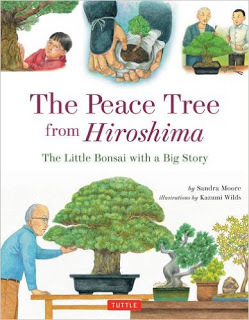
REACHING OUT/EXPLORING PEACEDiscussion: Read and talk about the book and the idea of two enemies giving and accepting gifts.Writing: Ask students to write in their journals about a time when they may have been angry with or hurt by a friend. Were they able to become friends again? What did they do to help heal the friendship?Sharing: As a class, talk about moving past anger and fear to peace and friendship. World Peace Day is celebrated on September 21 every year. It gives people around the world a chance to reflect on peace and do something to promote it, either as individuals or as a group. This guideincludes activities, from simple to complex, that might be done in the classroom. Ask students to jot down ideas of what they might do as an individual to promote peace. How about as a group of several friends or a classroom? And there’s no need to wait till September 21 to help promote peace; a new year offers a perfect opportunity to do something, whether big or small.
www.maryquattlebaum.com

Wars rage across the world, but rarely is there talk of the efforts undertaken by ordinary people to promote peace. Sandra Moore and Kazumi Wilds tell the story of one such effort in their picture book The Peace Tree from Hiroshima (Tuttle, ages 8 and up). This little bonsai was owned by the Yamaki family in Japan for almost 400 years, and it survived the U.S. atomic bombing of Hiroshima in 1945. In 1976, the family and the Japanese government gave the little tree to the United States, as a gift of friendship. Moore, the American author, and Wilds, the Japanese illustrator, talk about their bookmaking process in a KidsPost interview for the Washington Post.

REACHING OUT/EXPLORING PEACEDiscussion: Read and talk about the book and the idea of two enemies giving and accepting gifts.Writing: Ask students to write in their journals about a time when they may have been angry with or hurt by a friend. Were they able to become friends again? What did they do to help heal the friendship?Sharing: As a class, talk about moving past anger and fear to peace and friendship. World Peace Day is celebrated on September 21 every year. It gives people around the world a chance to reflect on peace and do something to promote it, either as individuals or as a group. This guideincludes activities, from simple to complex, that might be done in the classroom. Ask students to jot down ideas of what they might do as an individual to promote peace. How about as a group of several friends or a classroom? And there’s no need to wait till September 21 to help promote peace; a new year offers a perfect opportunity to do something, whether big or small.
www.maryquattlebaum.com
Published on December 14, 2015 14:00
December 7, 2015
Bring Me Your Tired, Your Poor…
by Karen Leggett Abouraya
For generations, American schoolchildren have learned that the United States is a nation of immigrants - melting pot, tossed salad, destination for the “huddled masses yearning to breathe free” welcomed by the Statue of Liberty.
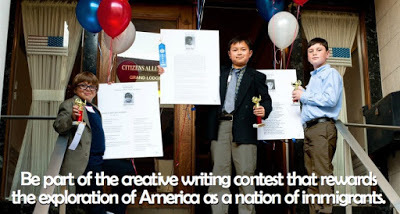
The issue of immigration is now fraught with controversy and polarizing politics, but it remains a worthy subject to challenge student thinking and writing. In fact, the American Immigration Council is sponsoring its 19th annual Celebrate America 5th Grade Creative Writing Contest. Students are asked to write 500 words on “Why I am glad America is a nation of immigrants.” Essays are due February 29, 2016. In Maryland, D.C. and Virginia, contest questions may be directed to essaycontestATsilversimmigration.com.
The Friends of the Library in Montgomery County, MD, also sponsors an essay contest on“Celebrating Diversity” with a January 29 deadline. This contest invites middle school students to submit an essay, short story or poem that is an expression of their culture. It is appropriately called “Mosaic.” With or without a contest, these writing prompts about immigration and culture can be adapted to any grade level.
Use the contest guidelines directly or simply ask students to find out when they or their families came to the United States and why.
Some families came willingly, some not and some were here long before immigration became a fact of American life. The question should prompt discussion at home and interesting stories or essays at school. If the question is too sensitive for some children to discuss publicly, they could talk to a neighbor or a school staff member instead.
There is a variety of books to inform the discussion and stimulate writing. The Institute for Humane Education lists 14 picture and chapter books about refugee children from Vietnam and Cambodia, Somalia, Mali, Pakistan and more. For older students, Kem Knapp Sawyer has just published Grace Akallo and the Pursuit of Justice for Child Soldiers. Akallo escaped the brutal Lord’s Resistance Army in Uganda and is now raising her family in Massachusetts while she advocates for peace and justice. Sawyer’s message in the book, as she explains in an interview with Deborah Kalb, is that Grace Akallo – after a tragic and frightening childhood - became an American immigrant with a “remarkable vision, who believes she was given a purpose in life, not to mourn for herself but to help others who have suffered as she has.”
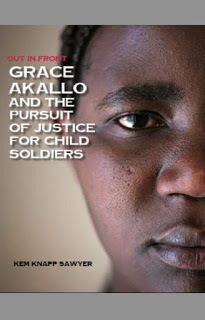
Last year, fifth grader Anya Frazier of Raleigh, NC, included these thoughts in the poem that won the American Immigration Council contest:
On each ship,A flicker of hope,A flash blinding my endless waters,But then it’s gone.Like a burnt out fire,Trying to reignite.But as they catch sight of the golden land,That fire begins to glow.It spreads out wide like a seed to soil,Its timid shoots poking out of the ground.Promise.
http://childrensbookguild.org/karen-leggett-abouraya
For generations, American schoolchildren have learned that the United States is a nation of immigrants - melting pot, tossed salad, destination for the “huddled masses yearning to breathe free” welcomed by the Statue of Liberty.

The issue of immigration is now fraught with controversy and polarizing politics, but it remains a worthy subject to challenge student thinking and writing. In fact, the American Immigration Council is sponsoring its 19th annual Celebrate America 5th Grade Creative Writing Contest. Students are asked to write 500 words on “Why I am glad America is a nation of immigrants.” Essays are due February 29, 2016. In Maryland, D.C. and Virginia, contest questions may be directed to essaycontestATsilversimmigration.com.
The Friends of the Library in Montgomery County, MD, also sponsors an essay contest on“Celebrating Diversity” with a January 29 deadline. This contest invites middle school students to submit an essay, short story or poem that is an expression of their culture. It is appropriately called “Mosaic.” With or without a contest, these writing prompts about immigration and culture can be adapted to any grade level.
Use the contest guidelines directly or simply ask students to find out when they or their families came to the United States and why.
Some families came willingly, some not and some were here long before immigration became a fact of American life. The question should prompt discussion at home and interesting stories or essays at school. If the question is too sensitive for some children to discuss publicly, they could talk to a neighbor or a school staff member instead.
There is a variety of books to inform the discussion and stimulate writing. The Institute for Humane Education lists 14 picture and chapter books about refugee children from Vietnam and Cambodia, Somalia, Mali, Pakistan and more. For older students, Kem Knapp Sawyer has just published Grace Akallo and the Pursuit of Justice for Child Soldiers. Akallo escaped the brutal Lord’s Resistance Army in Uganda and is now raising her family in Massachusetts while she advocates for peace and justice. Sawyer’s message in the book, as she explains in an interview with Deborah Kalb, is that Grace Akallo – after a tragic and frightening childhood - became an American immigrant with a “remarkable vision, who believes she was given a purpose in life, not to mourn for herself but to help others who have suffered as she has.”

Last year, fifth grader Anya Frazier of Raleigh, NC, included these thoughts in the poem that won the American Immigration Council contest:
On each ship,A flicker of hope,A flash blinding my endless waters,But then it’s gone.Like a burnt out fire,Trying to reignite.But as they catch sight of the golden land,That fire begins to glow.It spreads out wide like a seed to soil,Its timid shoots poking out of the ground.Promise.
http://childrensbookguild.org/karen-leggett-abouraya
Published on December 07, 2015 14:00
November 30, 2015
IF YOU COULD FLY ON A GIANT BIRD
by Jacqueline Jules
 In my picture book, Princess and the Ziz, a princess flies all over the world on the back of a giant yellow bird. The Princess and the Ziz is my own retelling of a very old Rapunzel tale involving King Solomon’s daughter who was rescued from a tower by a giant yellow bird called the Ziz.
In my picture book, Princess and the Ziz, a princess flies all over the world on the back of a giant yellow bird. The Princess and the Ziz is my own retelling of a very old Rapunzel tale involving King Solomon’s daughter who was rescued from a tower by a giant yellow bird called the Ziz.
During author visits, I often challenge young writers to imagine what it would be like to ride on the back of a giant bird. Where would you want to go? I’ve had many lively discussions with students about where they would like to go if they could ride in the air with a bird. While some students say the Bahamas, Disney World, or some other vacation spot, others tell me they’d like to visit grandparents or other relatives. One student told me she would like to fly over the rainbow with a giant bird. Now wouldn’t that make a good story!
Once a destination has been decided, students can brainstorm what they would see. If you are flying over Antartica, you might see penguins and snow. If you are flying over the jungle, you would see lots of greenery. Ask younger students to describe the scene in as much detail as possible. Older students could combine this writing exercise with geographic research. For example: If you were flying over Egypt, you would see pyramids. What else?
From there, students should consider what they would hear on their journey through the air. On the back of a bird, not enclosed the way you are in an airplane, you would hear the wind and the flapping of wings. Could you describe that? If you were flying over a city, you would hear the noise of traffic and building construction. What would that sound like? This could be an opportunity to encourage your students to use onomatopoeia. Students could make up their own words to imitate what they might hear from way up in the sky.
Finally, how would it feel to be in the sky on the back of a giant bird. Would you be frightened or excited? Would it be chilly? Would the ride be smooth or bumpy?
Visit my website for a writing template to use in your primary classrooms.
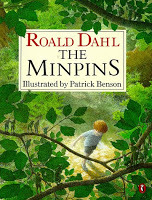 The Princess and the Ziz is certainly not the only book which depicts a character flying in the sky via a giant bird. In Roald Dahl’s The Minpins, Little Billy flies around the world having adventures on the back of a giant swan. Fairy tales also depict characters riding on the backs of birds. Thumbelina in the story by Hans Christian Andersen flies on the back of a swallow.
The Princess and the Ziz is certainly not the only book which depicts a character flying in the sky via a giant bird. In Roald Dahl’s The Minpins, Little Billy flies around the world having adventures on the back of a giant swan. Fairy tales also depict characters riding on the backs of birds. Thumbelina in the story by Hans Christian Andersen flies on the back of a swallow.
Ask your students to write their own story about a character flying with the help of a friendly bird. Imaginations and feathers can soar through the clouds. Happy Flying!
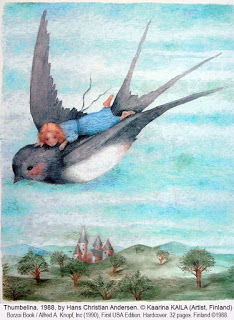
www.jacquelinejules.com
 In my picture book, Princess and the Ziz, a princess flies all over the world on the back of a giant yellow bird. The Princess and the Ziz is my own retelling of a very old Rapunzel tale involving King Solomon’s daughter who was rescued from a tower by a giant yellow bird called the Ziz.
In my picture book, Princess and the Ziz, a princess flies all over the world on the back of a giant yellow bird. The Princess and the Ziz is my own retelling of a very old Rapunzel tale involving King Solomon’s daughter who was rescued from a tower by a giant yellow bird called the Ziz. During author visits, I often challenge young writers to imagine what it would be like to ride on the back of a giant bird. Where would you want to go? I’ve had many lively discussions with students about where they would like to go if they could ride in the air with a bird. While some students say the Bahamas, Disney World, or some other vacation spot, others tell me they’d like to visit grandparents or other relatives. One student told me she would like to fly over the rainbow with a giant bird. Now wouldn’t that make a good story!
Once a destination has been decided, students can brainstorm what they would see. If you are flying over Antartica, you might see penguins and snow. If you are flying over the jungle, you would see lots of greenery. Ask younger students to describe the scene in as much detail as possible. Older students could combine this writing exercise with geographic research. For example: If you were flying over Egypt, you would see pyramids. What else?
From there, students should consider what they would hear on their journey through the air. On the back of a bird, not enclosed the way you are in an airplane, you would hear the wind and the flapping of wings. Could you describe that? If you were flying over a city, you would hear the noise of traffic and building construction. What would that sound like? This could be an opportunity to encourage your students to use onomatopoeia. Students could make up their own words to imitate what they might hear from way up in the sky.
Finally, how would it feel to be in the sky on the back of a giant bird. Would you be frightened or excited? Would it be chilly? Would the ride be smooth or bumpy?
Visit my website for a writing template to use in your primary classrooms.
 The Princess and the Ziz is certainly not the only book which depicts a character flying in the sky via a giant bird. In Roald Dahl’s The Minpins, Little Billy flies around the world having adventures on the back of a giant swan. Fairy tales also depict characters riding on the backs of birds. Thumbelina in the story by Hans Christian Andersen flies on the back of a swallow.
The Princess and the Ziz is certainly not the only book which depicts a character flying in the sky via a giant bird. In Roald Dahl’s The Minpins, Little Billy flies around the world having adventures on the back of a giant swan. Fairy tales also depict characters riding on the backs of birds. Thumbelina in the story by Hans Christian Andersen flies on the back of a swallow.Ask your students to write their own story about a character flying with the help of a friendly bird. Imaginations and feathers can soar through the clouds. Happy Flying!

www.jacquelinejules.com
Published on November 30, 2015 14:00
Mary Quattlebaum's Blog
- Mary Quattlebaum's profile
- 22 followers
Mary Quattlebaum isn't a Goodreads Author
(yet),
but they
do have a blog,
so here are some recent posts imported from
their feed.



